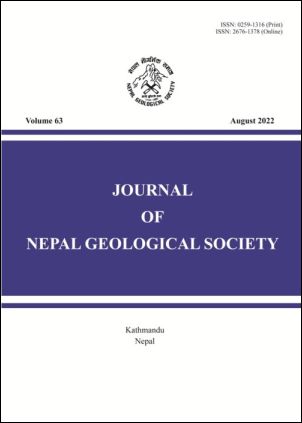Palynological study along the Triyuga River section from the Upper Siwalik sediment and its paleoclimatic implication
DOI:
https://doi.org/10.3126/jngs.v63i01.50822Keywords:
Coexistence Approach (CoA), Palynomorph, Paleoclimate, Upper SiwalikAbstract
The records of past vegetation and climate using palynological study from the Upper Siwalik sediment along the Triyuga River section, eastern Nepal discloses 117 taxa belonging to 36 families. Different palynomorphs from gymnosperm, angiosperm (dicotyledonous and monocotyledonous) and pteridophytes were identified some up to species level like Abies, Picea, Pinus, and Tsuga, Justicia, Strobilanthes, Betula, Terminalia, Artemisia, Corylus, Quercus, Liquidambar, Fraxinus, Salix, Symplocos, Urtica, Typha, Cyathea, Lygodium, Ceratopteris under light microscope. Some palynomorphs were identified up to their family level such as Anacardiaceae, Apocynaceae, Bombacaceae, Leguminosae, Malvaceae, Arecaceae, Liliaceae, and Poaceae. The palynomorphs from this section revealed diversity in vegetation with tropical-subtropical to lower temperate humid and warm climatical condition with plenty of precipitation throughout the time of deposition of the Upper Siwalik. Additionally, the Coexistence Approach (CoA) further highlighted this section experienced at the MAT 16.8-21.7°C, WMT 23.6-26.1°C, CMT 10.6-14.6°C, and MAP 1122-1682 mm, HMP 115-349 mm, LMP 19-73 mm, WMP 82-172 mm.
Downloads
Downloads
Published
How to Cite
Issue
Section
License
© Nepal Geological Society




